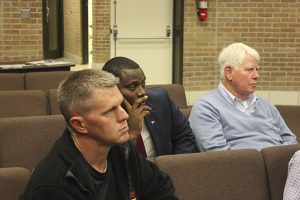
By DON FLETCHER
News Staff Writer
A November 14 public meeting to discuss the return of passenger rail service to lower Alabama left a lot of questions unanswered, but gave a glint of hope that the project would eventually bear fruit.
Brian Smart of global consultant AECOM, representing the Alabama Department of Economic and Community Affairs, was the moderator for the meeting, which was sparsely attended, possibly due to lingering rain and chilly winds.
Only 15 people attended the meeting. The audience included State Sen. Greg Albritton, State Rep. Alan Baker, Atmore Mayor Jim Staff and City Council Member Susan Smith, Escambia County Commissioners Brandon Smith and Karean Reynolds, county BOE member Coleman Wallace, former Southern Rail Commissioner Jerry Gehman and Robert Smith, director of planning for the City of Montgomery.
“We have several stakeholders in the room, and we’re glad to see that,” Smart noted as the meeting began. “We are going to discuss Phase II of the Montgomery-Mobile Passenger Rail Feasibility Study that encompasses Birmingham to Mobile. The piece we’re focusing on tonight is from Montgomery down to Mobile.”
Smart pointed out that the meeting was designed mainly to assure stakeholders and the public that the return of passenger rail service to the area was not a dead issue.
“We wanted a chance to come out and present to the public and our stakeholders what we’re doing, so you’ll know this study is ongoing and that there will be other opportunities for you to participate. And there will be times where we’re going to solicit input from all of you.”
The infrastructure consultant stood before a series of maps, charts and informational graphics that spelled out the study area and the results of Phase I, which dealt with passenger rail service from Birmingham to Montgomery and was completed in 2014.
He promised that more detailed information that is specific to Phase II would be presented in a second meeting that will take place in the spring of 2019.
“Through the fall and early next year we’re going to develop alternatives so that routes and alignments will be on the maps,” he said. “Also, when we come back for the second round of public and stakeholder meetings, we will have ridership and revenue analyses.
“Lastly, by fall of 2019 or before then, we will have our full, comprehensive final report that will be made public after it has been submitted to the United States Rail Administration. We’ll have the results of all our analysis and a summary of the input we receive from stakeholders and the public.”
About halfway through the session, Smart ended any speculation that the return of passenger rail service would become a reality anytime soon.
“When you talk about a study timeline … we’re looking at a new transportation project,” he explained. “Feasibility comes first, and the next thing — which could take two or three years — is an environmental review process and concept design work. Then there’s the preliminary engineering, final design and other phases in the process.”
Most of the questions raised by attendees related to topics that Smart said were not part of the initial study process, including rights-of-way and real estate.
“Now is not the phase of the process where you would discuss stuff like that,” he said.
Wallace asked why the possible return of passenger rail service to the area had suddenly re-appeared after Gov. Kay Ivey refused to commit state funds to the project.
“This has happened before; we’ve had these same conversations,” the BOE member said. “So why did this come back up at this time?”
Gehman, who was removed from the commission earlier this year for criticizing the governor’s decision, quickly interjected with a possible reason.
“A short answer is, because the state has the money,” he said.
Smart conceded that the project would require construction of “new structures, new bridges and other ancillary facilities.”
Passenger rail service along the Gulf Coast ended in 2005 after Hurricane Katrina destroyed or significantly damaged most of the rail infrastructure.
Ron Vile, a former railroad man who lives near Perdido, talked about potential rail routes and pointed out several potential snags in the plan.
“You have to look at all those to make a good choice,” Vile said. “I’ve seen a lot of choices, especially since Katrina, that haven’t been what I consider wise.”
Smart said he and other staff members working on the study would try to sell the state and federal governments on restoring passenger rail service to Alabama. He admitted that the group’s work is cut out for it.
“We are evaluating a potential passenger rail route that captures the most riders, and how we could make the argument that this system in itself is an important part of the transportation network and justifying having separate freight and passenger rail operations.”
